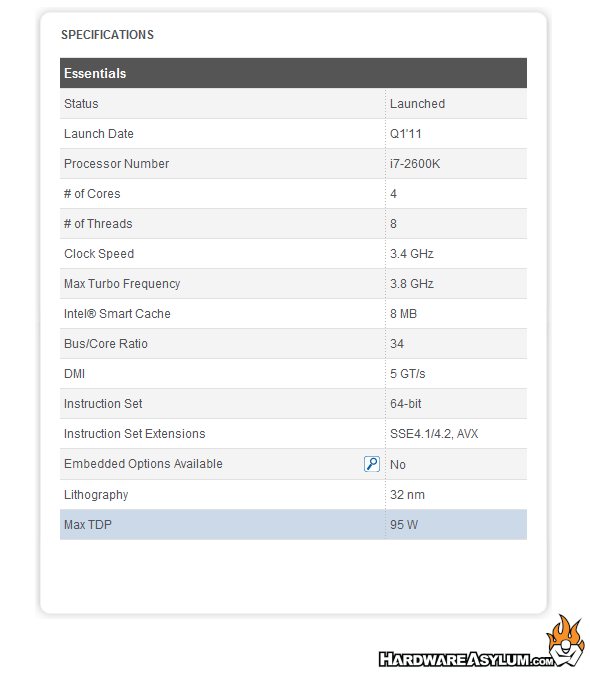Noctua L9x65 Low Profile Heatsink Review
Author: Dennis GarciaBenchmarks
The Noctua NH-L9x65 is designed to fit Intel Socket LGA2011 / 1156 / 1155 / 1150 and AMD processors. Here is an overview of the system and testing methodology.
Asus P8Z68 Deluze Gen3 Intel Z68 Chipset
Intel Core i7 2600K (3.5Ghz) Quad Core 4 x 256KB L2 Cache 8MB L3 Cache
Noctua NH-L9x65
Intel OEM Heatsink
The CPUID System Monitor was used to obtain and record system temperature data and being that this is a quad core processor we need something that will work across all of the cores at once. For this task we're using a new version of Prime95 (p95v255a) that will allow you to spawn (n) instances to test with.

Editors note: Even though the Windows 7 task manager reported 100% processor usage we could never attain a 100% of the rated heat output as documented by Intel (see below) when using Prime95 as a basis for that heat production. Knowing this we ran the stress test until the maximum temperature was attainted and stabilized.
Other things to consider when judging software induced heat output.
a) Clock throttling by the processor at high temperatures.
b) Normal software isn't designed to produce maximum heat output.
c) Variances of cooling temperature.
d) Variances in CPU load.
e) Inaccuracies in thermal diode readouts.
Of course the list goes on..
Our testing methodology is aimed to provide a real world look into this heatsink given the test system provided.

A C/W rating can quickly be calculated using this formula.
C/W = (CPU temp - Ambient temp)/(Variance(%) * CPU Watts)
Allowed variance for this test = 85%
CPU Watts = 95W
0.42 C/W = (55C - 21C)/(.85(95W))
For this next test the CPU speed was cranked up to 4.4Ghz using the ASUS TPU switch and the test was re-run.

To calculate a new C/W rating for this test we will need to factor in the increased processor wattage. The formula and constants for this are listed below.
ocC/W = dCPU Watts * (ocMhz / dMhz) * (ocVcore / dVcore)2
ocMhz = 4400
dMhz = 3500
ocVcore = 1.28
dVcore = 1.2
The variance still applies for our C/W calculation
Allowed variance for this test = 85%
CPU Watts = 135W
0.43 C/W = (71C - 21C)/(.85(135W))
In our heatsink and waterblock tests we don't really focus on overall load temperatures but rather how well the product can remove heat given a specified heat load. Since this is a real world testing method we need to take into consideration real world variables and estimate tolerances. This is why we normally only apply 85% of the total wattage output to our heat calculations.
The resulting C/W number is used to rate how efficient a heatsink or waterblock is based on the given heat load. These numbers can be used to determine heat capacity, the larger the difference the less efficient the heatsink is. (aka not good for overclocking)
Noctua clearly states that the NH-L9x65 is only recommended on processors with a TDP of 84w or lower making it incompatible with most LGA 115x and just about every LGA 2011 processor on the market. However, as our tests show the NH-L9x65 can handle a stock clocked 2600k (95w) and starts to reach its thermal threshold at 130w which is in the realm of the LGA 2011.
In our testing we tried pushing the limits of this heatsink and while it will run at 4.7Ghz the cooler reached its thermal limit and collapsed rather quickly. At this point we started reducing speed and voltage until we reached 4.4Ghz and were able to complete the heat test. Much to our surprise this was also the 130w threshold and the starting point for LGA 2011.
It should also be noted that we did test this heatsink using all fans spinning under the Asus Turbo PWM fan profile. This profile is a little more aggressive than the default enabling them to spin up faster under load. This isn’t matter much since even at stock speeds the fan would ramp up to 2000 rpm to maintain temperature.
Keep in mind these calculations are provided for demonstration purposes only and may not reflect the actual lab tested C/W rating, but we're pretty close.

